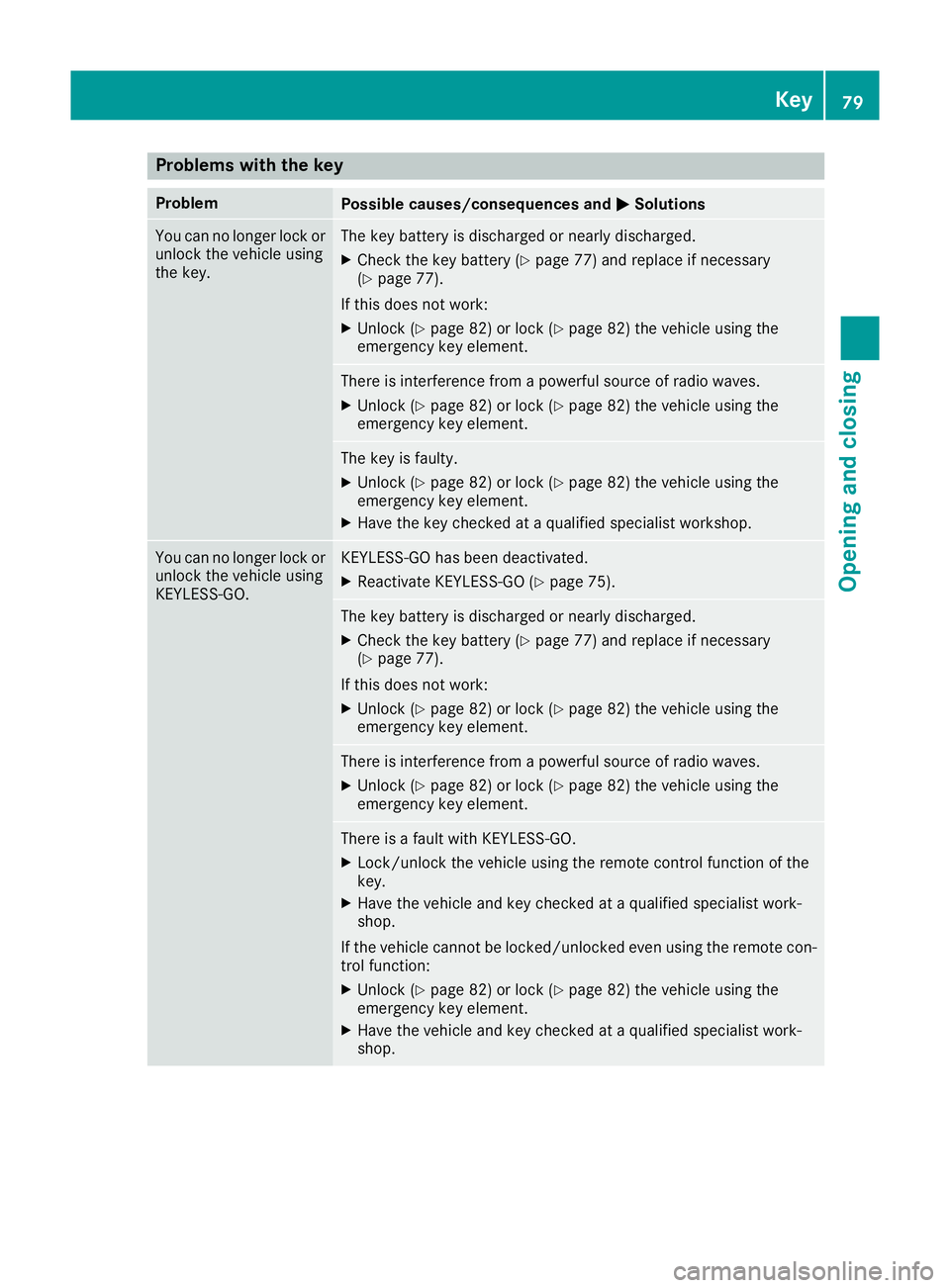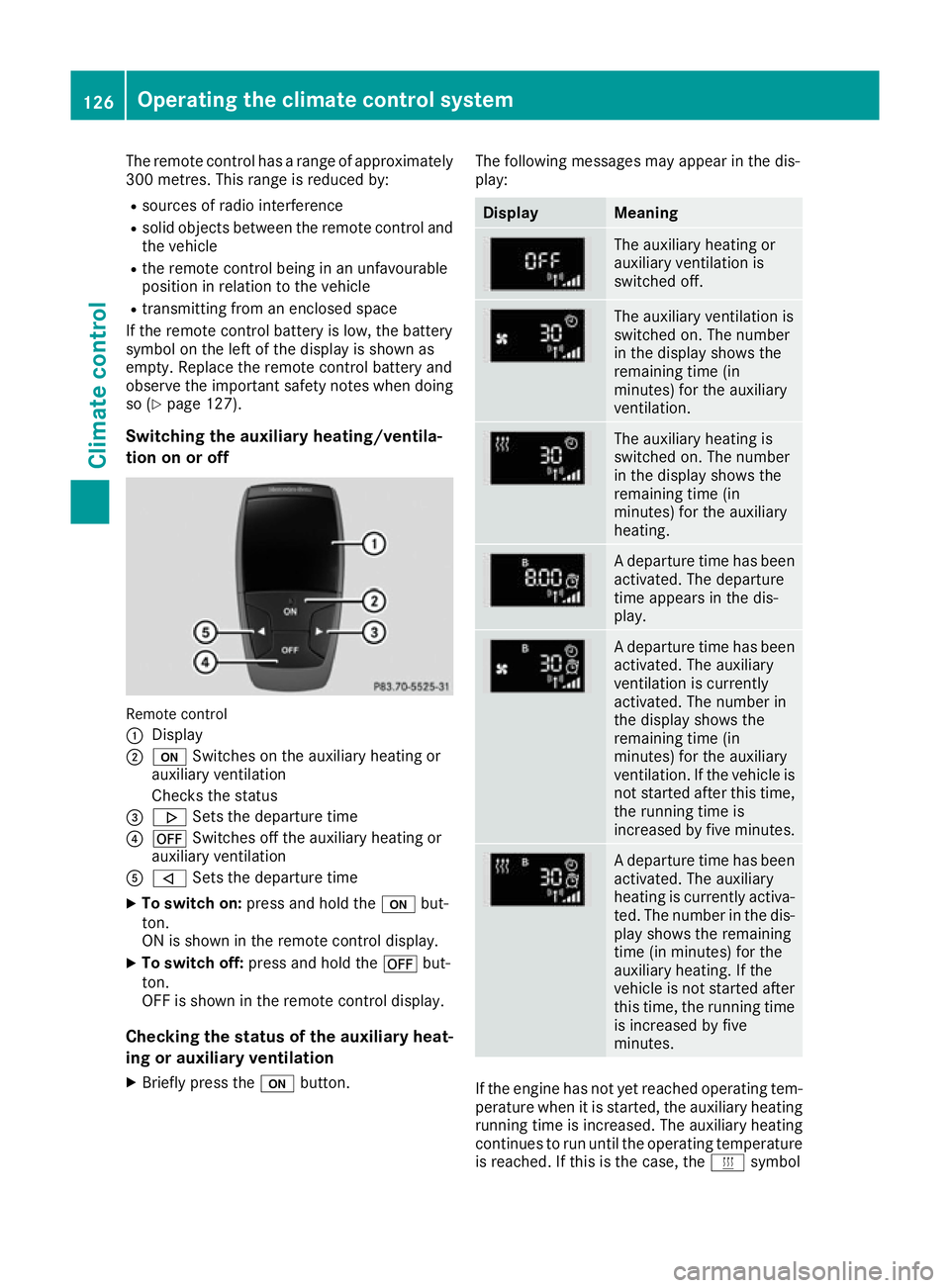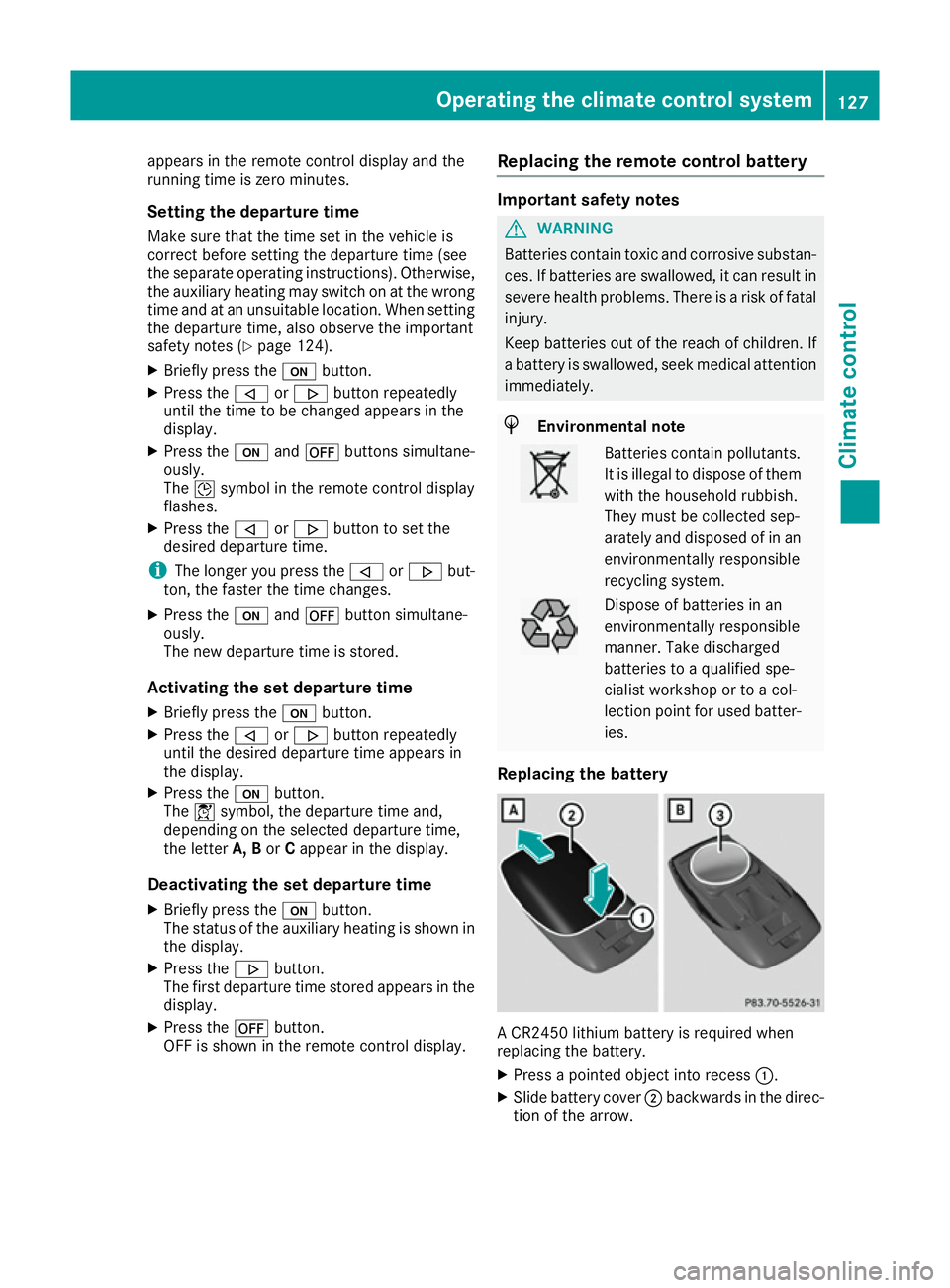2015 MERCEDES-BENZ E-CLASS COUPE remote control
[x] Cancel search: remote controlPage 7 of 345

Triggering ......................................... 44
Windowbag ...................................... 43
Alarm
ATA (Anti-Theft Alarm system) ......... 71
Switching off (ATA) .......................... 71
Switching the function on/off
(ATA) ................................................ 71
Alarm system
see ATA (Anti-Theft Alarm system)
Anti-glare film .................................... 282
Anti-lock braking system
see ABS (Anti-lock Braking System)
Anti-Theft Alarm system
see ATA (Anti-Theft Alarm system)
Aquaplaning ....................................... 154
Ashtray ............................................... 273
Assistance display (on-board com-
puter) .................................................. 213
Assistance menu (on-board com-
puter) .................................................. 213
ASSYST PLUS
Displaying a service message ........ 288
Hiding a service message .............. 288
Resetting the service interval dis-
play ................................................ 288
Service message ............................2 88
Special service requirements ......... 288
ATA (Anti-Theft Alarm system)
Activating/deactivating ................... 71
Function .......................................... .71
Switching off the alarm .................... 71
ATTENTION ASSIST
Activating/deactivating ................. 215
Display message ............................ 234
Function/note s............................. 189
Audio 20
Switching on/of f........................... 256
Authorised workshop
see Qualified specialist workshop
AUTO lights
Display message ............................ 230
see Lights
Automatic engine start (ECO start/
stop function) .................................... 136
Automatic engine switch-off (ECO
start/stop function) .......................... 135
Automatic headlamp mode .............. 106Automatic transmission
Accelerator pedal position ............. 142
Automatic drive program ............... 144
Changing gear ............................... 142
DIRECT SELECT lever ..................... 140
Display message ............................ 241
Drive program display .................... 140
Driving tips .................................... 142
Emergency running mode .............. 147
Engaging drive position .................. 142
Engaging neutral ............................ 141
Engaging park position automati-
cally ............................................... 141
Engaging reverse gear ................... 141
Engaging the park position ............ 141
Kickdown ....................................... 143
Manual drive progra m.................... 144
Manual drive program (vehicles
with Sports package AMG) ............ 145
Overview ........................................ 140
Problem (fault) ............................... 147
Program selector button ................ 143
Pulling away ................................... 134
Starting the engine ........................ 134
Steering wheel gearshift paddle s... 144
Trailer towing ................................. 143
Transmission position display
(DIRECT SELECT lever) ................... 140
Transmission positions .................. 142
Automatic transmission emer-
gency running mode ......................... 147
Auxiliary heating
Activating/deactivating ................. 125
Important safety notes .................. 124
Setting ........................................... 219
Auxiliary heating/ventilation
Display message ............................ 244
Problem (display message) ............ 129
Remote control .............................. 125
Setting the departure time ............. 127
Switching on/off (on the centre
console) ......................................... 125
Auxiliary ventilation
Activating/deactivating ................. 125
Axle load, permissible (trailer tow-
ing) ...................................................... 336 4
Index
Page 19 of 345

R
Radiator cover ................................... 285
Radio
Selecting a station ......................... 211
see separate operating instructions
Radio mode
See also Digital Owner's Manua l... 256
Radio-based vehicle components
Declaration of conformity ................ 25
Rain closing feature
Panorama sliding sunroo f................ 89
Reading lamp ..................................... 110
Rear compartment
Setting the temperature ................ 120
Rear foglamp
Display message ............................ 229
Switching on/of f........................... 107
Rear seat
Display message ............................ 243
Rear window blind ............................ 273
Rear window heating
Problem (fault) ............................... 123
Switching on/of f........................... 122
Rear-compartment seat belt sta-
tus indicator ........................................ 41
Rear-view mirror
Anti-dazzle mode (automatic) ........ 103
Dipping (manual) ........................... 102
Refuelling
Fuel gaug e....................................... 30
Important safety notes .................. 147
Refuelling process ......................... 148
see Fuel
Remote control
Auxiliary heating/ventilation .......... 125
Changing the batteries (auxiliary
heating) ......................................... 127
Garage door opener ....................... 276
Programming (garage door
opener) .......................................... 277
Replacing bulbs
Important safety notes .................. 111
Overview of bulb types .................. 111
Replacing the battery (auxiliary
heating remote control) .................... 127
Rescue card ......................................... 26 Reserve (fuel tank)
see Fuel
Reserve fuel
Display message ............................ 232
Warning lamp ................................. 252
Residual heat (climate control) ........ 124
Restraint system
Display message ............................ 228
Introduction ..................................... 36
Problem (malfunction) ................... 251
Warning lamp (function) ................... 37
Rev counter ........................................ 206
Reverse gear
Engaging (manual transmission) .... 139
Reversing camera
Cleaning instructions ..................... 293
Display in the multimedia system .. 182
Function/note s............................. 181
Switching on/of f........................... 181
Reversing feature
Panorama sliding sunroo f................ 89
Roller sunblind s............................... 90
Side windows ................................... 85
Sliding sunroof ................................. 89
Reversing lamp (display message) .. 229
Roller sunblind
Panorama sliding sunroo f................ 90
Rear window .................................. 273
Roof lining and carpets (cleaning
instructions) ...................................... 295
Roof load (maximum) ........................ 335
Route guidance
See also Digital Owner's Manua l... 256 S
Safety Children in the vehicle ..................... 47
see Occupant safety
Safety system
see Driving safety systems
SD memory card
Ejecting .......................................... 263
Inserting ........................................ 263
Inserting/removing ........................ 263
See also Digital Owner's Manua l... 256
Selecting ........................................ 211 16
Index
Page 77 of 345

Key
Important safety notes
United Kingdom only: G
WARNING
When the double locks are activated, the
doors can no longer be opened from the
inside. People in the vehicle can no longer get out, e.g. in hazardous situations. There is a
risk of injury.
Therefore, do not leave any people unsuper-
vised in the vehicle, particularly children, eld-
erly people or people in need of special assis-
tance. Do not activate the double lock when
people are in the vehicle.
If the vehicle has been locked from the outside, the double lock function is activated as stand-
ard. It is then not possible to open the doors
from inside the vehicle. You can deactivate the
double lock function by deactivating the interior
motion sensor (Y page 73). The doors can then
be opened from the inside after the vehicle has
been locked from the outside. The anti-theft
alarm system is triggered if the door is opened
from the inside. Switch off the alarm
(Y page 71).
All countries: G
WARNING
If children are left unsupervised in the vehicle, they could:
R open doors, thereby endangering other per-
sons or road users
R get out and be struck by oncoming traffic
R operate vehicle equipment and become
trapped, for example
In addition, the children could also set the
vehicle in motion, for example, if they:
R release the parking brake
R shift the automatic transmission out of park
position P or shift manual transmission into
neutral
R start the engine
There is a risk of an accident and injury. When leaving the vehicle, always take the key
with you and lock the vehicle. Never leave
children and animals unattended in the vehi-
cle. Keep the keys out of the reach of children. G
WARNING
If you attach heavy or large objects to the key, the key could be unintentionally turned in the
ignition lock. This could cause the engine to
be switched off. There is a risk of an accident.
Do not attach any heavy or large objects to the
key. Remove any bulky keyrings before insert-
ing the key into the ignition lock.
! Keep the key away from strong magnetic
fields. Otherwise, the remote control function could be affected.
Strong magnetic fields can occur in the vicin-
ity of powerful electrical installations.
Do not keep the key: R with electronic devices, e.g. a mobile phone
or another key
R with metallic objects, e.g. coins or metal film
R inside metallic objects, e.g. a metal case
This can affect the key's functionality. Key functions
:
& Locks the vehicle
; F Unlocks the boot lid
= % Unlocks the vehicle
X To unlock centrally: press the%button.
If you do not open the vehicle within approx-
imately 40 seconds of unlocking:
R the vehicle locks again
R protection against theft is reactivated 74
KeyOpening and closing
Page 82 of 345

Problems with the key
Problem
Possible causes/consequences and
M
MSolutions You can no longer lock or
unlock the vehicle using
the key. The key battery is discharged or nearly discharged.
X Check the key battery (Y page 77) and replace if necessary
(Y page 77).
If this does not work: X Unlock (Y page 82) or lock (Y page 82) the vehicle using the
emergency key element. There is interference from a powerful source of radio waves.
X Unlock (Y page 82) or lock (Y page 82) the vehicle using the
emergency key element. The key is faulty.
X Unlock (Y page 82) or lock (Y page 82) the vehicle using the
emergency key element.
X Have the key checked at a qualified specialist workshop. You can no longer lock or
unlock the vehicle using
KEYLESS-GO. KEYLESS-GO has been deactivated.
X Reactivate KEYLESS-GO (Y page 75). The key battery is discharged or nearly discharged.
X Check the key battery (Y page 77) and replace if necessary
(Y page 77).
If this does not work: X Unlock (Y page 82) or lock (Y page 82) the vehicle using the
emergency key element. There is interference from a powerful source of radio waves.
X Unlock (Y page 82) or lock (Y page 82) the vehicle using the
emergency key element. There is a fault with KEYLESS-GO.
X Lock/unlock the vehicle using the remote control function of the
key.
X Have the vehicle and key checked at a qualified specialist work-
shop.
If the vehicle cannot be locked/unlocked even using the remote con-
trol function:
X Unlock (Y page 82) or lock (Y page 82) the vehicle using the
emergency key element.
X Have the vehicle and key checked at a qualified specialist work-
shop. Key
79Opening and closing Z
Page 128 of 345

When the auxiliary heating is switched on,
make sure that:
R no flammable materials come into contact
with hot vehicle components
R the exhaust gas can escape from the
exhaust pipe unhindered
R the exhaust gas does not come into contact
with flammable materials.
The auxiliary heating and the exhaust gas dis-
charge location can be found in front of the right-
hand front wheel.
! Operating the auxiliary heating/ventilation
draws on the vehicle battery. After you have
heated or ventilated the vehicle a maximum of two times, drive for a longer distance.
i Switch the auxiliary heating on regularly
once a month for about ten minutes.
The auxiliary heating heats the air in the vehicle interior to the set temperature. This occurs with-out using the heat of the running engine. The
auxiliary heating is operated directly using the
vehicle's fuel. For this reason, the tank content
must be at least at reserve fuel level to ensure
that the auxiliary heating functions.
The auxiliary heating/ventilation automatically
adjusts to changes in temperature and weather
conditions. For this reason, the auxiliary heating could switch from ventilation mode to heating
mode or from heating mode to ventilation mode.
The auxiliary heating switches off automatically
after 50 minutes. This time limit can be altered. To do this, visit a qualified specialist workshop.
You cannot use the auxiliary ventilation to cool
the vehicle interior to a temperature lower than
the outside temperature.
Before switching on X
Turn the key to position 2in the ignition lock
(Y page 132).
X Set the desired temperature.
Auxiliary heating or auxiliary ventilation can also be switched on if the manually set climate con-
trol is activated. Optimum comfort is attained by
setting the system to automatic mode. Set the
temperature to 22 †.
The auxiliary heating or auxiliary ventilation can
be switched on/off using the button on the
centre console or the remote control. The on-board computer can be used to specify
up to three departure times, one of which may
be preselected (Y page 219).
Switching the auxiliary heating/venti-
lation on or off using the button on the
centre console The colours of the indicator lamps in button
:
mean the following:
R blue: auxiliary ventilation is switched on
R red: auxiliary heating is activated
R yellow: departure time is preselected
(Y page 219)
X To switch on the auxiliary heating or aux-
iliary ventilation:
press button:.
The red or blue indicator lamp in button :
lights up.
X To switch off the auxiliary heating or aux-
iliary ventilation: press button:.
The red or blue indicator lamp in button :
goes out.
Switching the auxiliary heating/venti-
lation on or off using the remote control General notes
Your vehicle comes with one remote control.
You may use two additional remote controls for
your vehicle. For more information, please con-
tact a qualified specialist workshop.
Store the remote control for the auxiliary heat-
ing so that the auxiliary heating cannot be
switched on unintentionally. In particular,
ensure that the remote control for the auxiliary
heating is kept out of the reach of children. Operating the climate control system
125Climate control Z
Page 129 of 345

The remote control has a range of approximately
300 metres. This range is reduced by:
R sources of radio interference
R solid objects between the remote control and
the vehicle
R the remote control being in an unfavourable
position in relation to the vehicle
R transmitting from an enclosed space
If the remote control battery is low, the battery
symbol on the left of the display is shown as
empty. Replace the remote control battery and
observe the important safety notes when doing so (Y page 127).
Switching the auxiliary heating/ventila-
tion on or off Remote control
:
Display
; u Switches on the auxiliary heating or
auxiliary ventilation
Checks the status
= . Sets the departure time
? ^ Switches off the auxiliary heating or
auxiliary ventilation
A , Sets the departure time
X To switch on: press and hold the ubut-
ton.
ON is shown in the remote control display.
X To switch off: press and hold the ^but-
ton.
OFF is shown in the remote control display.
Checking the status of the auxiliary heat- ing or auxiliary ventilation
X Briefly press the ubutton. The following messages may appear in the dis-
play: Display Meaning
The auxiliary heating or
auxiliary ventilation is
switched off.
The auxiliary ventilation is
switched on. The number
in the display shows the
remaining time (in
minutes) for the auxiliary
ventilation.
The auxiliary heating is
switched on. The number
in the display shows the
remaining time (in
minutes) for the auxiliary
heating.
A departure time has been
activated. The departure
time appears in the dis-
play. A departure time has been
activated. The auxiliary
ventilation is currently
activated. The number in
the display shows the
remaining time (in
minutes) for the auxiliary
ventilation. If the vehicle is
not started after this time, the running time is
increased by five minutes. A departure time has been
activated. The auxiliary
heating is currently activa-
ted. The number in the dis- play shows the remaining
time (in minutes) for the
auxiliary heating. If the
vehicle is not started after
this time, the running time is increased by five
minutes. If the engine has not yet reached operating tem-
perature when it is started, the auxiliary heating running time is increased. The auxiliary heating
continues to run until the operating temperature
is reached. If this is the case, the ysymbol 126
Operating the climate control systemClimate control
Page 130 of 345

appears in the remote control display and the
running time is zero minutes.
Setting the departure time Make sure that the time set in the vehicle is
correct before setting the departure time (see
the separate operating instructions). Otherwise, the auxiliary heating may switch on at the wrong
time and at an unsuitable location. When setting
the departure time, also observe the important
safety notes (Y page 124).
X Briefly press the ubutton.
X Press the ,or. button repeatedly
until the time to be changed appears in the
display.
X Press the uand^ buttons simultane-
ously.
The Îsymbol in the remote control display
flashes.
X Press the ,or. button to set the
desired departure time.
i The longer you press the
,or. but-
ton, the faster the time changes.
X Press the uand^ button simultane-
ously.
The new departure time is stored.
Activating the set departure time
X Briefly press the ubutton.
X Press the ,or. button repeatedly
until the desired departure time appears in
the display.
X Press the ubutton.
The Ísymbol, the departure time and,
depending on the selected departure time,
the letter A, BorCappear in the display.
Deactivating the set departure time
X Briefly press the ubutton.
The status of the auxiliary heating is shown in the display.
X Press the .button.
The first departure time stored appears in the
display.
X Press the ^button.
OFF is shown in the remote control display. Replacing the remote control battery Important safety notes
G
WARNING
Batteries contain toxic and corrosive substan- ces. If batteries are swallowed, it can result in
severe health problems. There is a risk of fatal injury.
Keep batteries out of the reach of children. If
a battery is swallowed, seek medical attention immediately. H
Environmental note Batteries contain pollutants.
It is illegal to dispose of them
with the household rubbish.
They must be collected sep-
arately and disposed of in anenvironmentally responsible
recycling system. Dispose of batteries in an
environmentally responsible
manner. Take discharged
batteries to a qualified spe-
cialist workshop or to a col-
lection point for used batter-
ies.
Replacing the battery A CR2450 lithium battery is required when
replacing the battery.
X Press a pointed object into recess :.
X Slide battery cover ;backwards in the direc-
tion of the arrow. Operating the climate control system
127Climate control Z
Page 131 of 345

X
Insert new battery =with the lettering facing
upwards.
X Slide battery cover ;in the opposite direc-
tion to the arrow on the remote control until it engages. 128
Operating the climate control systemClimate control